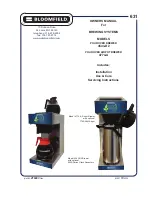
LUBRICATION
Before returning chain to service or after replacing a load
chain, lubricate liberally with Bar and Chain Oil such as
Lubriplate
®
10-R (Fiske Bros, Refining Co.) or equivalent, Be
sure the lubricant reaches the bearing surfaces between the
links. Remove excess lubricant from chain by wiping with a
clean, dry cloth.
The hoist normally requires no lubrication, except for
periodically lubricating the load chain or when the unit is
disassembled for periodic inspections, cleaning or repairs.
The brake is designed to operate dry. Do not use any grease
or lubricant on the braking surfaces. When lubricating parts
adjacent to the brake, do not use an excessive amount of
lubricant which could seep onto the brake surfaces.
When the hoist is disassembled for periodic inspections,
check the pawl for free movement and apply a light coat of
spray lubricant such as WD-40 (WD-40 Co.) or equivalent, to
the pawl stud. When the hoist is disassembled for cleaning or
repairs, the following locations should be lubricated using
approximately 1 oz. (29.5 ml) per hoist of Extreme Pressure
Grease such as Molykote BR-2-S (Dow Corning Corp.) or
equivalent:
Gears, liftwheel rollers, upper hook pin, rollers of the liftwheel
bearing, inside of chain guide roller, exterior of pinion shaft,
surface of ratchet hub pawl, and surface of cam guide and
gear cover brushings.
NOTE: To assure extra long life and top performance, be sure
to lubricate the various parts of the hoist using the lubricants
specified.
ASSEMBLY
Particular attention must be given to the following when
assembling the hoist:
Thread the friction hub onto the pinion shaft and assemble the
friction discs and the ratchet on the friction hub (See Figure 6).
Place the spring over the friction hub and pinion. Place the
brake cover assembly on the frame and thread the lever ratchet
onto the pinion shaft. Firmly seat the lever ratchet and secure
the brake cover assembly to the frame using the four nuts.
Place the check washer on the pinion shaft so that there is
0.094 to 0.312 inches (2 to 8 mm) between the edge of the
check washer and the raised stop on the lever ratchet hub
(See Figure 7).
Make sure the directional lever is in the neutral (“N”) position
and the pawl, spring and shaft are in the lever assembly,
attach the lever assembly to the brake cover using the two
locknuts, screw and lockwasher. Place the free chaining knob
on the lever ratchet hub. Place the spacer over the pinion
shaft, thread the brake nut onto the pinion shaft, and firmly
tighten the nut. Back off the nut one to two flats and insert the
cotter pin. Bend the legs of the cotter pin to secure.
When assembling the latch to the hook, the end of the rivet
must be peened over. When peening over rivet, only apply
enough force to form a head to retain the pin. Excessive force
will deform the latch and make the latch inoperable.
When assembling the gears, they must be orientated with the
timing marks aligned (See Figure 8).
To reduce the risk of injury, avoid contact with
lubricants. Handle and dispose of lubricants only as
directed in applicable Material Safety Data Sheets and
in accordance with applicable local, state and federal
regulations.
To reduce the risk of injury, never use used motor oil as
a chain lubricant. Used motor oil contains known
carcinogenic materials. Use only Bar and Chain Oil such
as Lubriplate
®
10-R or equivalent as a lubricant for the
load chain.
To reduce the risk of injury, do not use any grease or
lubricant on braking surfaces. The brake is designed to
operate dry. Using any grease or lubricant on the
braking surfaces will cause brake slippage and loss of
load control which may result in injury and/or property
damage.
Ratchet
Figure 6
Friction
Hub
Ratchet
Friction
Disc
Pawl
Pawl
Figure 7
0.094 to 0.312"
(2 to 8 mm)
Lever
Ratchet
Check
Washer
Raised
Stop


































